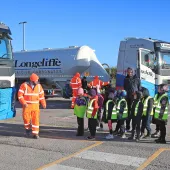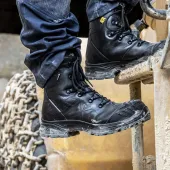Choosing the right vehicle camera system

Emily Hardy from Brigade Electronics provides some technical insight and useful advice
VEHICLE camera systems have become commonplace on HGVs, trucks, construction vehicles and heavy equipment. As well as aiding driver manoeuvrability, they support road and site safety by eliminating vehicle blind spots and helping to prevent incidents. However, deciding which vehicle camera to install can be difficult, so what camera options are available, how should they be applied and is it worth upgrading to high-definition (HD) format.
Front-view cameras
Recommended for: machinery, road-going haulage and delivery vehicles
Due to the size and elevated driver position of machinery and trucks, a blind spot often exists to the front. A front-view camera will eliminate this blind spot and help to prevent front vehicle damage. When choosing a camera, it is worth bearing in mind health and safety directives in particular sectors to ensure that these are fully covered.
For example, ISO 5006 stipulates that operators of earthmoving machinery must be able to see a person 1.5m high within a 1m perimeter around the machine. Additionally, for HGVs, blind-spot directive 2003/97/EC (Class VI) stipulates that a front-view camera is mandatory for forward speeds below 30km/h.
Side-view cameras
Recommended for: road-going vehicles, including HGVs, construction, waste and refuse vehicles
The nearside blind spot is accountable for many collisions. Most cyclist fatalities happen at low speeds, typically at road junctions and when pulling away from a stationary position.
Rear-view cameras
Recommended for: all vehicles
Regardless of the type of vehicle, the rear blind spot is a huge problem, with 90% of reversing incidents occurring off road, whilst a quarter of workplace deaths are caused by reversing vehicles. Reversing cameras are, therefore, a crucial piece of technology to prevent costly collisions, reduce damage and save lives.
360-degree cameras
Recommended for: all vehicles
Intelligent camera monitor systems, such as Brigade’s Backeye 360, are designed to assist low-speed manoeuvring by providing the driver with a complete all-round view of the vehicle in real time.
Ultra-wide-angle cameras mounted to the front, sides and rear of the vehicle capture the surrounding areas, including all blind spots. Simultaneous images from these cameras are processed and ‘video stitched’ resulting in a 360-degree bird’s-eye view in a single image.
Shutter cameras
Recommended for: construction, quarrying, and waste and recycling
A shutter camera can improve the life and visibility of a reversing camera considerably. Where vehicles operate in harsh environments, reversing cameras usually accumulate dirt and dust on the lens, which can block the driver’s view and render the camera useless. The shutter protects the camera by only revealing the lens when it is in use, reducing its exposure time significantly. Brigade’s shutter camera can operate temperature as low as –40 degrees C and has built-in heaters to melt ice, allowing it to function effectively even in extreme temperatures.
Vehicle CCTV cameras
Used for: recording footage both inside and outside a vehicle
Incidents involving vehicles are time-consuming issues to resolve. Where there are conflicting reports of actual events or when trying to prove a staged accident, having recorded footage means companies can make major cost savings in the long-term. More importantly, such footage can also support the driver, who is often the subject of increased scrutiny after an incident. Vehicle CCTV cameras provide an accurate witness and irrefutable evidence in the case of an incident.
Should I use high-definition vehicle cameras?
Among the most recent additions to the vehicle camera system portfolio are high-definition (HD) cameras. These provide images in HD format, which are clearer and more defined. This makes HD particularly suitable for industries such as construction and quarrying where safety is a huge concern.
However, there are a number of factors to consider before making the jump to HD. For example, if a vehicle already has a CCTV system installed, it is most likely not compatible with the HD camera. Likewise, recording in HD format will require more data and, therefore, use up a lot more space on a hard drive or tear through the data allowance for cloud-based storage far more quickly.
In the event of a security incident, HD cameras are ideal for recording footage, supplying clearer images and making it easier to identify individuals, number plates and other important information that may be required as evidence.









